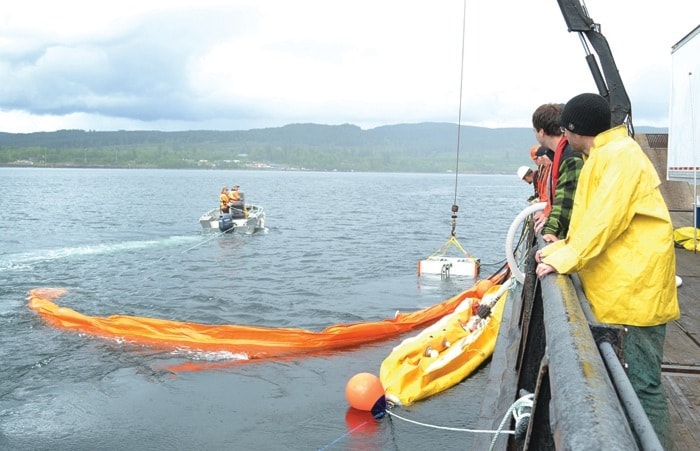Standing on the deck of a landing craft in Menzies Bay, during an oil spill clean-up training session, Troy Donovan glances over at Seymour Narrows.
Described by Captain George Vancouver as “one of the vilest stretches of water in the world,” tides reach up to 15 knots and funnel through the Narrows creating huge whirlpools and several other hazards.
“You can just imagine how difficult it would be to clean up oil off the beaches in Seymour Narrows,” says Donovan who works for Sea Romer Marine Services.
It’s not hard to imagine the devastation an oil spill could wreak on the whales, seal lions, seals, dolphins, sea birds and other wildlife that feed in the Narrows.
On the night of May 11, a cruise ship heading through Seymour Narrows ran across a long towline of aluminum containers used for fish farms. Several of the containers were damaged, but the accident could have potentially sunk the small tugboat resulting in leaks of oil, diesel fuel and environmentally-hazardous materials.
Fortunately disaster was averted, but there’s always the potential for an oil spill and that’s why the marine and logging-oriented contractors are here.
They spent Tuesday in the classroom and Wednesday is hands-on day on the water. There are 22 contractors here for training provided by the Western Canada Marine Response Corporation.
The corporation’s mandate is to ensure its members are prepared for hazardous spills on the water and to mitigate the impacts.
This includes the protection of wildlife, economic and environmental sensitivities, and the safety of both the responders and the public.
“We have equipment caches up and down the coast, including here in Campbell River,” says Chris O’Malley, the corporation’s operations supervisor for Vancouver Island.
But the specialized equipment is useless if you don’t have locally-trained people who know how to use the booming gear, sea slugs, skimmers and other gear essential for clean-ups.
Even still, the response time for a clean-up after an emergency in the Campbell River area is approximately 18 hours. In that time, the tides change and will carry oil into sensitive bays and onto beaches.
That’s why the training includes placing diversion booms in front of an environmentally-sensitive lagoon that borders the Ripple Rock Trail.
A little further south, another crew practices flushing the beach of oil using pressured sea water. It’s easier, explains one trainee, to collect oil off the water than from a rocky or sandy beach.
On board the 120-foot Inlet Explorer landing craft, O’Malley directs the third crew on how to enclose a spill using floating booms and how to use a disc skimmer that collects floating oil in a sea slug bladder.
“If it’s collecting too much water, that’s not good,” he tells the crew. “You have to adjust it so it’s just skimming oil – all of it needs to be properly treated and if you’re collecting water, well, it gets expensive.”
The Western Canada Marine Response Corporation is run by five major shareholders and receives funding through a bulk oil handling fee imposed on companies transporting oil through Canadian waters. It also has subscribers and charges fees for spill clean-ups.
The organization was involved in clean-ups following the sinking of BC Ferries Queen of the North and the overturned barge which dumped logging equipment into the depths surrounding the Robson Bight Ecological Reserve.
Training sessions on the Island also take place in Port Hardy, Nanaimo, Victoria and Port Alberni.
“We’re here at Menzies Bay because of the fast-moving waters around here,” says O’Malley. “Training also gives us the opportunity to better familiarize ourselves with the coast.”
Accidents will occur and being ready is the key to minimizing damage as well as keeping clean-up costs down. It’s a situation Mike Murphy is a well-aware of as he works on the Inlet Transporter which carries fuel to logging camps, resorts and remote homes.
“This is all relevant to us because that’s what we do, carry fuel,” he says.
To learn more, visit www.wcmrc.com
